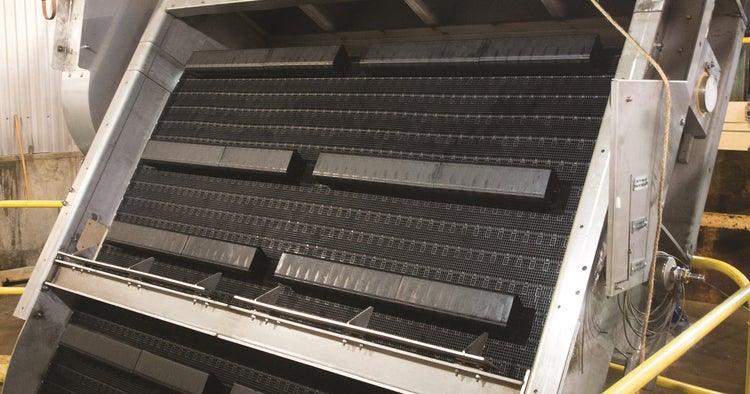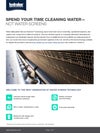A Future Dependent on Desalination
Hydrolox experts are helping ensure the success of these crucial plants worldwide
- Insights
- January 12, 2024

For many parts of the world, water scarcity has become a consistent threat.
“Despite the fact that we have warming oceans and melting ice caps, we also have drought,” says Tim Woodrow, Vice President for Hydrolox. “Desalination is already a way of life for many parts of the world, such as the Middle East, but it is increasingly becoming a reality for areas that have traditionally have bountiful supplies for fresh water, such as many areas of southern Europe and even the U.S. in Texas and California.”
It’s a localized threat now—but one that spreads as the world’s climate continues to change.
“So many regions are already increasingly dependent on desalination, and the need is growing,” says Gianluca Genchi, Global Business Development Manager for Hydrolox. “Water is a bare necessity.”
When basic human needs become scarce, ingenuity by those who provide them must become plentiful. Innovation becomes a new bare necessity. Costly time drains like complicated maintenance and unexpected downtime start to bring even more dire consequences.
We caught up with our experts to discuss the current state of the desalination industry, its future, and how our paradigm-shifting water screen technology can ensure the success of these crucial plants worldwide.
Beat the Drum
Desalination is more important than ever, but also more challenging—the world is changing. Shouldn’t intake technology change as well? Shouldn’t it rise to meet these challenges?
“We’re mapping the Middle East at the moment,” Genchi says. “There are a lot of drum screens and dual flow screens. It’s the same chain-driven equipment over and over again in these plants. There hasn’t been any innovation to them in the last 100 years.”
It was an unusual idea to begin with, expecting essential metal parts to last for any noteworthy amount of time while rotating in and out of water. But especially as salinity rises, the traditional water screen design becomes problematic.
“Metallic moving parts going in and out of the water—it’s not a good mix,” Woodrow says. “It only gets exasperated as we move into harsher environments like the Middle East, where corrosion is just rampant.”
Corrosion is a huge issue across industries, but especially in desalination—where water cleanliness is key—it can tank your operation’s production.
“The Gulf States jokingly call themselves the corrosion capital of the world,” says David Weller, Project Manager for Hydrolox.
“The salinity levels in the Middle East are very high,” Genchi adds. “So especially in seawater environments there's a lot of corrosion and biofouling, which doesn't affect our non-metallic screens made of engineered polymer."
Adding in this biofouling endemic of traditional screens in saltwater environments, the whole chain-driven enterprise becomes untenable.
“If biofouling occurs, it can ruin the plant’s membrane,” Genchi explains. “It’s a critical component. When the membrane is corrupted, the water is undrinkable, so this biofouling requires frequent shutdown for membrane changeouts.”
"Our engineered polymer screens don’t corrode," Weller says. "And they’re more resistant to biofouling. They'll just keep running. It's one of the things that really, I think, will separate us from the other manufacturers very quickly in these regions.”
But in addition to increased salinity, the world’s changing waters present another new threat: jellyfish blooms. Traveling in swarms comprised of hundreds of thousands—even millions—jellyfish have become a huge threat to desalination plants and the water they provide.
“If there’s a jellyfish bloom that forces a plant to shut down, they can lose millions of dollars a day,” Genchi says. “And these traditional screens really can’t handle the blooms. In the desalination world, we’re then talking about a community’s drinking supply at risk.”
“Certain places may only have five days’ worth of drinking water reserved,” says Weller. “They make it and use it. They don’t have the luxury of going offline.”
It’s why we designed Hydrolox screens to handle the most extreme debris loads this new environment can throw at them—without needing to stop operations for maintenance or repairs.
When our partners buy our product, they’re buying reliability.
Vice President for Hydrolox
“We already have answers,” Genchi says. “We purposefully designed our flights and buckets to take aquatic wildlife and extreme debris out of the water. Our screens also run faster—that’s more jellyfish out of the way. And of course, our polymer mesh is supported by its unique chevron-patterned carryway, which bears most of that extreme force so the screen doesn’t have to.”
The alternative to this design, as always, is frequent and costly maintenance to screening technology not suited for extreme debris events.
“Plants with traditional screens need divers to go and inspect their chains,” Genchi says. “One I visited had around 20 people just managing the intake. They had divers permanently in the water removing sargassum. It was their whole job, removing this organism from the intake.”
In addition to their extreme load-bearing capabilities, Hydrolox screens are also largely self-cleaning thanks to their spray-bar cleaning system. This feature in particular has been well received by our partners as labor becomes scarce.
“When you talk about megatrends, we’re seeing a reduction in workforce and maintenance crews around the world,” Woodrow says. “How many people are available to actually work on screens? Should they really even be working on screens? Or are there other areas of the plant where they could provide more value?”
“Labor will continue be a challenging market for these plants,” Weller adds. “That means they’ll have to run for long periods of time with low maintenance. Having your intake go down for an extended period of time in regions that don’t have much water is catastrophic. It’s just not an option for them. Our ability to reduce maintenance burden is critical.”
Team Building
When it’s the difference between a future without clean water and one with it, innovation becomes a group project. It’s just as crucial that new plants are built as it is that they’re built to last through changing environments and markets.
“The number of these plants will only continue to grow,” Genchi says. “They’re popping up in drought-heavy regions now to perform desalination, but I already see a few of them contributing to green hydrogen production.”
Genchi explains that proper water is necessary for electrolysis in hydrogen production that requires a very clean water product.
“New plants will continue to be built at sea; not just for drinking water, but to produce green hydrogen,” Genchi says.
Regardless of what they’re producing, power consumption is a constant concern for these plants.
“They’re power hogs,” Genchi says. “If we can offer technology that doesn’t consume as much power, as well as increases generation by keeping the condensers cleaner, that creates a huge savings.”
This is where front-end collaboration becomes critical.
Success Spotlight: Thames Water
Hydrolox water screens ensures Eels Regulations compliance for Thames Water
“We can partner with consulting engineers and customers as they're building plants,” Weller says. “We can bring a whole new paradigm to the drawing board—before they get too far down the road and realize they need to buy 10 screens because all that will fit are 3-meter-wide screens.”
Plants need to be ready for the future in terms of changing environments and new production demands. Functionally, that means they need both the best technology available and the technology with the lowest cost of ownership—something that seems impossible.
And it was—until Hydrolox did it.
“Traditional screens are limited in width,” Weller explains. “They can’t really go wider than 3.5 meters. Ours can go to almost any width. We can work with our partners and their consulting engineers to create the perfect fit based on their draw or other needs.”
Paradoxically, because our screens can be built wider than traditional screens, our technology allows for dramatic reductions in the overall water intake structure. This is especially true of drum screens.
“We can reduce the real estate by around 30% versus a traditional screen,” Genchi says, “and by 60% or more with drum screens.”
Because our screens can be built to whatever width our partners require, Hydrolox technology can drastically reduce the number of screens needed, both improving performance and reducing maintenance and civil costs.
“We did a study once of an intake plant with 15 screens,” Weller shares. “By building our screens a half-foot wider than theirs could go, we were able to fit the plant with nine screens rather than 15. That’s a real estate savings of about 30%, but also a 30% reduction in the number of units they had to pay for up front. When it’s time to compare prices, it’s not apples to apples. You have to ask how big the apple is.
“We challenged one company recently that said they needed four screens,” Weller continues. “We were doing the math and couldn't figure out why they needed it—we could do what they needed with two. They came back and said it was a redundancy play. They were used to a certain amount of redundancy. With our screens, we could provide the desired redundancy with just two wide screens. They’re as wide as you need, and they don’t break.”
Combining these reduced real estate and unit requirements with a lack of maintenance and downtime, our partners report that return on investment is usually achieved within our industry-leading four-year warranty period.
Our return on investment isn’t the only thing that’s fast. Our front-end collaboration also means greater agility, as we partner with in-region fabricators to maintain the shipping and installation lead times Intralox is known for.
“In Israel in particular, installation time is a huge factor,” Genchi says. “If they spend too much time on the installation, their schedule slips, and the engineering, procurement, and construction firm is forced to pay penalties to the end user. Our quick, easy installation is a huge factor for them and many others.”
For them, it’s installation speed. Others may prioritize footprint reduction above all else. Or draw, or condenser cleanliness. The point is, whatever factors define success for your operation, we’ll meet them when we work together.
Download the industry highlight
Want to learn more about the Hydrolox design features changing the desalination industry’s expectations of their water screen technology?
A Reliably Inventive Partner
We know that when the world depends on you, you depend on us.
“When our partners buy our product, they’re buying reliability,” Woodrow says.
That’s why we’ll never stop asking you for problems to solve.
“We spent two years studying the existing technology, interviewing owners and operators of these screens, and understanding what their problems were,” Woodrow says.
That job is never over, and we’re continuously working to improve our technology—and your operation.
“It doesn’t matter what the industry is,” Woodrow continues. “They just want a reliable, maintenance-free piece of equipment that doesn’t fail when the going gets tough. That’s what we’ve designed. It’s what we’ll always supply.”


